1. What kind of light do I have in my home?
2. How much time do I have to check on and water my plant?
3. What type of insect am I hoping to rid my home of?
Now, let's look at our options and their specific care needs.

Dionaea "Venus Fly Trap"
Prey: Crawling Insects - Spiders, Centipedes, Ants, etc.
Light: They will thrive in full sun, meaning at least six hours of direct light.
Water: These plants need to sit in a dish of water at all times. Keep the top moss moist with top watering every few days. They do not want to dry out but try not to flood the top of the traps with water.

Pinguicula "Butterwort"
Prey: Fungus Gnats, Fruit Flies, Mosquitos.
Light: 6-8 hours of bright light, a few hours of direct sun preferred.
Water: These plants need to sit in a dish of water at all times. Keep the top moss moist with top watering every few days.
 Drosera "Sundew"
Drosera "Sundew"
Prey: Fungus Gnats, Fruit Flies, Mosquitos.
Light: 6-8 hours of direct light. If your plant is not producing enough dew, it needs more light.
Water: These plants need to sit in a dish of water at all times. Keep the top moss moist with top watering every few days.
 Nepenthes "Pitcher Plant"
Nepenthes "Pitcher Plant"
Prey: Crawling Insects - Spiders, Centipedes, Ants, etc.
Light: Most Nepenthes enjoy very bright, diffused light or partly sunny conditions. Nepenthes require at least three hours of direct light if grown indoors on a windowsill. If you notice your plant has stopped making pitchers, it is often a sign that the plant needs a bit more light.
Water: These plants like their potting medium to remain moist, but do not like to sit in water for extended periods of time. All pots must have drainage holes! Be sure to pour water through the pot and soil mix frequently to make sure all the mix remains moist.
 Sarracenia "American Pitcher Plant"
Sarracenia "American Pitcher Plant"
Prey: Crawling Insects - Spiders, Centipedes, Ants, etc.
Light: Sarracenia prefer full sun, meaning at least six hours of direct light. Sometimes the lids of Sarracenia will slightly burn, this is the sweet nectar burning in the hot sun, it is totally normal.
Water: These plants need to sit in a dish of water at all times. Keep the potting medium moist by top watering every few days. Be sure to check your water levels frequently in the summer.
SOIL
Carnivorous plants require a specific type of soil that is low in nutrients and high in acidity. A mix of moss and peat is commonly used to mimic their natural habitat. Never use traditional potting mix, and this usually contains fertilizers and other chemicals that will be detrimental to your plant.
FEEDING
While carnivorous plants can capture insects on their own, they do not necessarily need to be fed insects. Carnivorous plants can also survive off sunlight alone. However, if you choose to feed them, make sure the insects are small and alive to trigger their natural feeding response. These plants like soil that is NOT nutrient dense, never feed these plants with fertilizer.
Dormancy
There are many different varieties of each of these carnivorous plants that grow in different climates - make sure you research your variety so you can provide it the proper care during its dormancy.
Sources: https://www.petflytrap.com/Sarracenia-Maroon--NEW-LOWER-PRICE_p_3057.html https://www.californiacarnivores.com/apps/help-center










Leave a comment